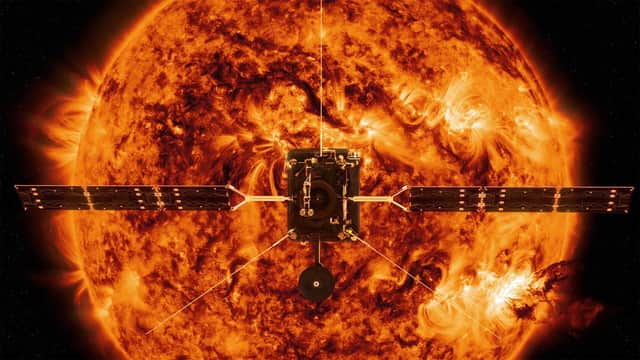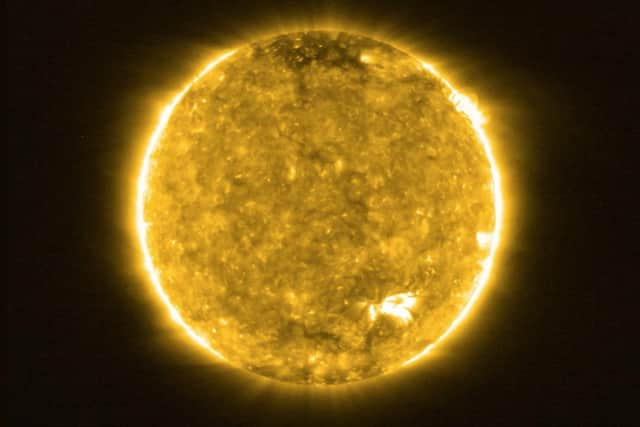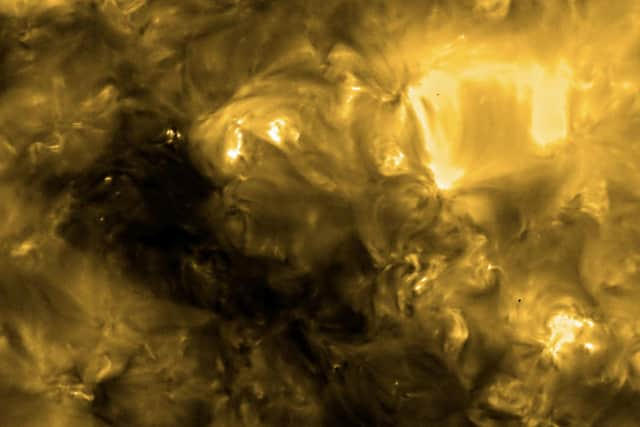Amazing 'closest ever' images of the Sun show 'campfires' on surface


The images were captured last month by the Solar Orbiter, a European Space Agency probe designed and built in the UK, when it came within 47 million miles of the Sun's surface.
The close pass, known as a perihelion, put the spacecraft between the orbits of Venus and Mercury.
Advertisement
Hide AdAdvertisement
Hide AdSolar flares are brief eruptions of high-energy radiation from the Sun's surface, which can cause radio and magnetic disturbances on the Earth.Dr Caroline Harper, head of space science at the UK space agency, said that scientists were excited by the presence of campfires that are "millions of times smaller than the solar flares".


She said: "We do not really know what they (the campfires) are doing but there is speculation that they might play a role in coronal heating, a mysterious process whereby the outer layer of the Sun, known as the corona, is much hotter (around 300 times) than the layers below.
"These campfires may be contributing to that in a way we do not know yet."
To find out more, scientists will monitor the temperatures of these campfires using an instrument on the spacecraft known as Spectral Imaging of the Coronal Environment, or SPICE.
Aside from helping unlock the mysteries of coronal heating, the Solar Orbiter will also help scientists piece together the Sun's atmospheric layers and analyse the solar wind, the stream of highly energetic particles emitted by the star.


Understanding more about solar activity could also help scientists make predictions on space weather events, which can damage satellites in orbit and disrupt the infrastructure on Earth that mobile phones, transport, GPS signals and the electricity networks rely on.Dr Harper said: "The science will allow us to start improving our operational capability to predict the space weather, just like you predict the weather here on Earth."
The spacecraft will make a close approach to the Sun every five months, and at its closest will only be 26 million miles away, closer than the planet Mercury.
It will use the gravitational force of Venus and Earth to adjust its trajectory, before getting into operational orbit in November 2021.
Advertisement
Hide AdAdvertisement
Hide AdDr Harper said: "At that point, it will send back much more data about the Sun's surface.
"It will also be flying over the poles of the Sun and take images."
The Solar Orbiter was constructed by Airbus in Stevenage and blasted off from Nasa's Cape Canaveral site in Florida on February 10.
It has been designed to withstand the scorching heat from the Sun that will hit one side, while maintaining freezing temperatures on the other side of the spacecraft as the orbit keeps it in shadow.
"It is really quite exciting to be involved (in the mission),” said Dr Harper.
"We have leading roles on four of the 10 scientific instruments on board the Solar Orbiter.
"For me, it showcases the UK's world-leading role in solar physics research and its capabilities in the industrial space sector."
A message from the Editor:
Thank you for reading this story on our website. While I have your attention, I also have an important request to make of you.
Advertisement
Hide AdAdvertisement
Hide AdThe dramatic events of 2020 are having a major impact on many of our advertisers - and consequently the revenue we receive. We are now more reliant than ever on you taking out a digital subscription to support our journalism.
Subscribe to scotsman.com and enjoy unlimited access to Scottish news and information online and on our app. Visit https://www.scotsman.com/subscriptions now to sign up.
By supporting us, we are able to support you in providing trusted, fact-checked content for this website.
Joy Yates
Editorial Director